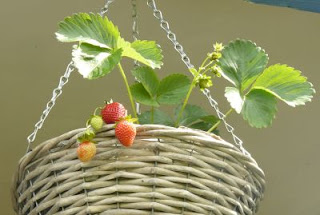Matters horticultural and arthropodological
I apologise for the flood of posts to this blog recently, and especially 2 posts in a day today. Of course it is all to do with the excellent rainfall, which has meant there is so much going on that I wish to record. Whether I need to share it all with others is an interesting point of philosophy to which I shall return in my review of the year!
As I seem to have close to 20 images in this post I have cut the size down a bit. I think they still get the idea across.
Anyway we will start off with a strawberry image. This is not from the vegie garden (still cranking out 2 litres + per day - yummo!) but a hanging basket above the deck. This is the first time we have tried this and to get fruit at once is great.
We will now have a few flowers, in ascending rank of "nativeness" and, after introducing insects in the natives, will get more exotic again, A parabolic post!!
About the least native flower I can think of is a rose. They are pretty however.
Love in the mist isn't far behind as a non-native! Interestingly, when I used that plant name for the file name the image was rejected by the server. Some people must have deviant minds!
I am not sure if this is English or not. It is putting on a great show this year: Cistus.
The next two images Penstemon and Salvia are of plants greatly enjoyed by Eastern Spinebills. What more does a plant need to do to be welcome in a garden?
Now we move to natives with a couple of Callistemons.
In my blog about the friarbird I inferred that insects are fond of Callistemons. So here are a couple of insects that look interesting but are completely unidentified by me. Any suggestions for these, or the ones which follow, would be welcome. Sorry the first one is such a poor image but I liked the red line across the back and chestnut antennae.
The next three are more or less to illustrate the wide range of body styles being adopted by insects. The first image is a Mayfly (but all reference material seems to be about the nymphs - possibly because the adults live such brief lives).
Finally some butterflies.
This is the first time I have come across a good use for Kiss-me-quicks (the plant being fed upon). I am glad I didn't try to call the images that!
As I seem to have close to 20 images in this post I have cut the size down a bit. I think they still get the idea across.
Anyway we will start off with a strawberry image. This is not from the vegie garden (still cranking out 2 litres + per day - yummo!) but a hanging basket above the deck. This is the first time we have tried this and to get fruit at once is great.
We will now have a few flowers, in ascending rank of "nativeness" and, after introducing insects in the natives, will get more exotic again, A parabolic post!!
About the least native flower I can think of is a rose. They are pretty however.
Love in the mist isn't far behind as a non-native! Interestingly, when I used that plant name for the file name the image was rejected by the server. Some people must have deviant minds!
I am not sure if this is English or not. It is putting on a great show this year: Cistus.
The next two images Penstemon and Salvia are of plants greatly enjoyed by Eastern Spinebills. What more does a plant need to do to be welcome in a garden?
Now we move to natives with a couple of Callistemons.
In my blog about the friarbird I inferred that insects are fond of Callistemons. So here are a couple of insects that look interesting but are completely unidentified by me. Any suggestions for these, or the ones which follow, would be welcome. Sorry the first one is such a poor image but I liked the red line across the back and chestnut antennae.
The next three are more or less to illustrate the wide range of body styles being adopted by insects. The first image is a Mayfly (but all reference material seems to be about the nymphs - possibly because the adults live such brief lives).
Finally some butterflies.
- The first is unknown (I suspect Common Brown),
- the second species (2 images) is the Caper White which is migrating through Carwoola as for Robertson; and
- the final species the Australian Admiral.
This is the first time I have come across a good use for Kiss-me-quicks (the plant being fed upon). I am glad I didn't try to call the images that!




















Comments